Joining ropes for long abseils
Introduction
Whilst I was surfing around on the internet, I came across various websites that provided warnings, or information, or advice, on how to join two ropes together, for long abseils.
There are several websites that describe fatalities believed to have been caused by people abseiling down ropes joined together using either figure-of-eight knots, or overhand knots. Yet despite these websites, there is still some advice being given on using an overhand knot - this advice is largely based on the fact that an overhand knot isn`t symmetrical, the bulk of the knot is off to one side of the rope, so when the ropes are getting pulled down, the knot sticks up in the air rather than lying against the rock face, so is less likely to snag on projections on the rock face.
Here is what the single overhand knot looks like -
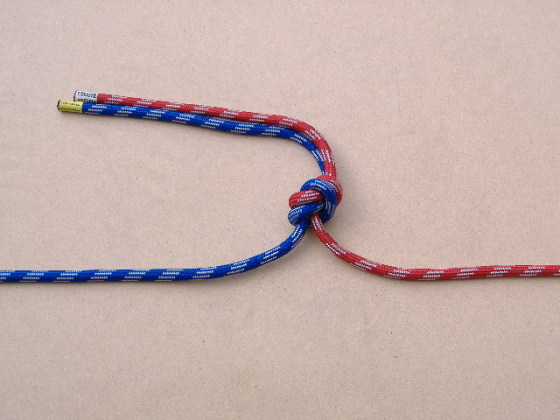
However the single overhand knot can "roll" down the tails when the ropes are put under tension, and will then fail.
There seems to be a general concensus on the web, that the use of a figure-of-net knot, tied as shown below, is not a safe knot to use either, as it also can "roll" down the tails under tension, and eventually roll off the end of the tails. It is not the correct way to join two ropes using a figure-of-eight knot.
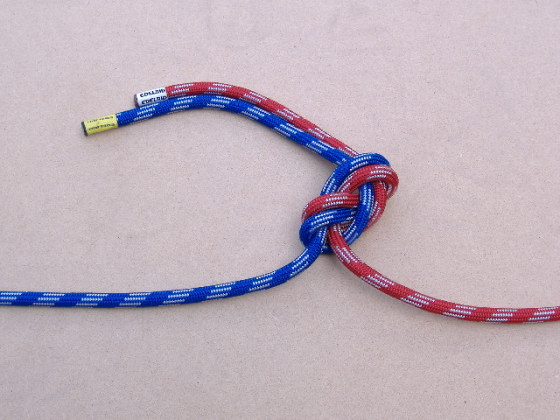
DO NOT USE either of the above two knots for joining two ropes in any kind of life threatening situation, such as abseiling - both of them are liable to roll down the tails when the ropes are tensioned, and will then fail.
Static load testing
There is quite an interesting webpage about some tests done on the strength of knots using facilities at Lyon Equipment - these tests showed that of the three types of knot tested, a double overhand knot was the strongest. Here is what a double overhand knot looks like.
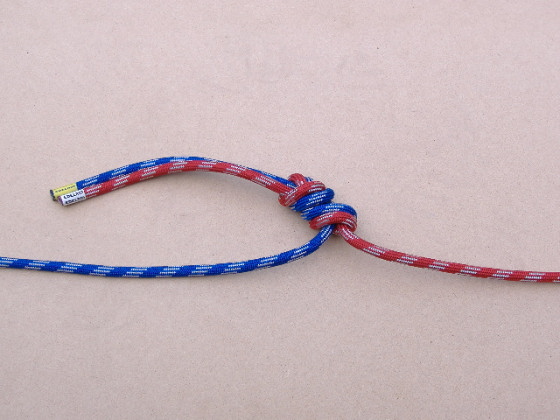
However there are several reasons why I think that these tests are not the final word on this -
The first of these is that these tests were performed to prove that an overhand knot was preferable to an off-set figure-of-eight knot - but I have never seen in any standard reference about knots, about climbing, or about caving, that this use of an off-set figure-of-eight knot is a recommended way of joining two ropes. The correct way to use a figure-of-eight knot to join two ropes is to use it in-line, as shown here -
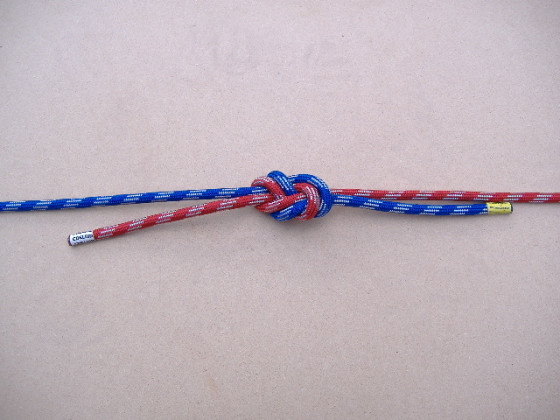
In real life, in a critical situation, you would back it up by adding a stopper knot on each rope.
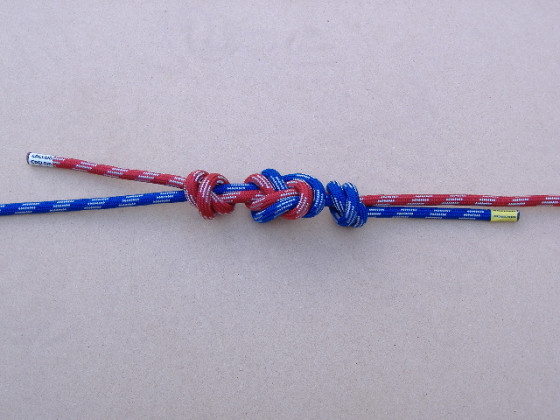
So in reality, all the tests have proved is that a double overhand knot is stronger than a knot which is tied the wrong way.
The second reason is that the tests were done in a somewhat sterile, static, environment - in real life, the knot would be subjected to various other factors, not just the static weight of the abseiler. These include -
- the abseiler bouncing - it is very difficult to abseil smoothly down a rope, progress is usually accompanied by a bit of bouncing - these bounces are going to be transmitted up the rope to the knot, and the knot will be subject to quite big variations in the load
- the kind of rope - static rope has a bit of bounce, but dynamic rope, which is what climbers should be using, will produce more bounce - this will produce more complex variations in the loading on the knot, though they will not neccessarily produce higher peak tensions
- the kind of abseil device - strange as it may seem, I think this will have an effect on the knot - it is well known that figure-of-eight descenders twist the rope - this twist will presumably be transmitted up the rope to the knot, and twisting the rope when trying to undo knots that have cinched up is a standard way of trying to undo the knot
- sheath slippage - it is a well known characteristic of kermantle ropes that the sheath can slip on the core, and cause a bundle of sheath at the end of the rope - both prussiking up a rope with jumars and abseiling down a rope are significant causes of sheath slippage - so the next time the rope is knotted at the end to join it to another rope, the knot is tied on top of bunched up loose sheath - when the rope is tensioned, there is now an incorrect distribution of the tension in the rope, between the sheath and the core - this must have an effect on the integrity of the knot, and hence the strength of the knot, and also on the strength of the rope itself
Effect of a knot on the strength of the rope
Another factor that we have to look at is the effect of a knot on the strength of a rope - every type of knot reduces the strength of a rope by some greater or lesser amount, so for example, if you are tying a loop in the end of a rope
- an overhand knot will reduce the strength of the rope to around 60% of its original strength
- a figure-of-eight knot will reduce the strength of the rope to around 70% of its original strength
- a figure-of-nine knot will reduce the strength of the rope to around 80% of its original strength
Please do be sure I am talking here about the effect of the knot on the strength of the rope itself, not the strength of the knot.
So we can see that the overhand knot is guilty of reducing the strength of the rope by a greater amount than any of the other knots, and this weakening effect will be just the same when the overhand knot is used to join two ropes.
I haven`t found any hard evidence as to by how much an overhand knot reduces the strength of the rope, when used to join two ropes, but the concensus seems to be that the loss in strength is more than 50% - ie - the strength of the rope is halved by the overhand knot.
This may not be of too much significance if we are using ropes with a high intrinsic strength, such as 10.5 or 11 mm ropes. However there is a constant move towards thinner ropes, where the intrinsic strength is significantly lower. On some occasions, when I want to travel light, I have used down to 8mm static ropes for abseiling, and they work really well. But weakening caused by knots is something to be aware of.
( And so is abrasion - thinner ropes are much more vulnerable to abrasion, because the tension in each strand of the rope is higher )
We can try and quantify this weakening effect, and by how much it puts us at risk.
8mm static rope has a typical shear force of around 15kn`s -
- An overhand knot reduces the strength of the rope to 7.5 kn`s
- An abseiler weighing 100kg`s exerts a downward static force of 1kn
- So the safety factor is 7.5:1
- If the rope is doubled, then the downward force on each half of the rope is approximately halved, and the safety factor goes up to 15:1
Doing the same calculation based on, for example, an in-line figure of eight, which reduces the strength of the rope to around 70% of its unknotted strength, gives safety factors of 10.5:1 ( single rope ) and 21:1 ( double rope ).
Good practice suggests that a safety factor of 10:1 is the minimum safety factor acceptable in life threatening situations.
So both the single and the double overhand knot reduce the safety factor in the strength of the rope compared to other knots, and it could be an issue, in particular on a single rope.
And remember, these figures are for a static weight - if there is any bounce when abseiling ( and there is always some bounce ) then the dynamic loads on the rope are considerably higher than these static loaded figures, and the safety factors will be seriously erroded.
So where do we go from here ?
It is generally reckoned that the strongest knot for joining two ropes is the Double Fisherman knot, also known as a Grapevine knot. It is the knot which is invariably used to make prussic loops, and in static tension tests, it has been shown that the rope will break before the Double Fisherman knot fails.
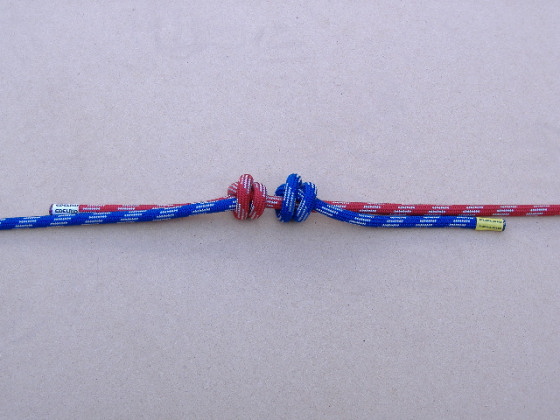
However this knot does suffer a disadvantage, when used to join ropes for abseiling - once it has been loaded hard, it is very difficult to undo. That isn`t a problem with prussik loops, as you don`t generally ever want to untie them. But it is a problem for abseiling.
One solution is to use the in-line figure-of-eight knot, with double stopper knots, as shown in the photograph higher up the page - here it is again.

However the in-line figure-of-eight knot suffers from two disadvantages when used in the field -
- it is a slow knot to tie, as you have to tie a figure-of-eight in one rope, then laboriously feed the other rope through the knot
- it is essential to dress it properly, and it is not an easy knot to dress correctly
The best solution therefore seems to be to use the absolutely classic combination that is well documented, of a reef knot, supported by double stopper knots.
It is basically the same as a Double Fisherman knot, but it is split in the middle by a reef knot.
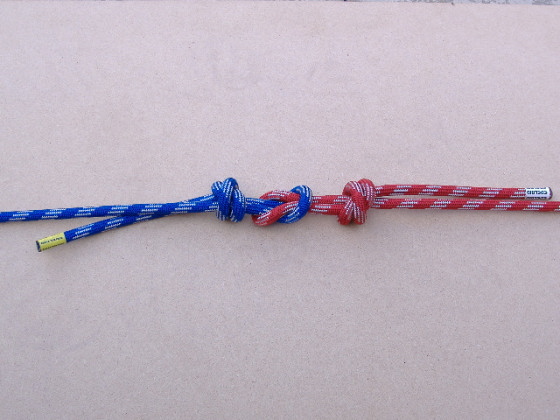
It works well, it is quite easy to setup, and it is easy to undo after it has been loaded. It is a lot quicker to tie a reef knot than an in-line figure-of-eight knot, and it is a lot easier to dress correctly. And both knots require the double stopper knots to back them up.
NEVER - EVER - use a reef knot in any kind of critical situation, without the stopper knots backing it up. A reef knot, used by itself, can slip.
A reef knot is also known as a square knot.
Snagging on the pull down
As mentioned right at the start, one of the reasons that is touted for using an overhand knot to join two abseil ropes is that the bulk of the overhand knot is offset from the centre of the rope, so offers a reduced likelihood of the knot snagging on the rock face, as it is getting pulled down after the abseil.
However I don`t think that one should get too hung up on this - yes, I can see the arguement here, and yes, it can be a serious problem if a knot snags when the rope is getting pulled down - but I think we need to try and quantify the advantages of the overhand knot over other knots in this respect.
As far as I can see, the only situation in which the overhand knot has an advantage is where the rock face is characterised by sharp horizontal, or near horizontal, edges.
There is no advantage where the rock projections are rounded. There is no advantage where there are vertical, or near vertical, slots into which the rope drops, with the knot catching at the start of, or further down, the slot.
In fact I will argue that a double overhand knot is more likely to catch in a slot, since there is a big lump of knot sticking out to the side. With the reef/double stopper combination, all the knots are in line, and are smaller in bulk than the double overhand knot.
Here is the two of them side by side, and you can see that the double overhand knot has a lot more bulk than the reef/double stopper knot, even though it is all out on one side.

Incidentally, another advantage of the reef/double stopper knot over the figure-of-eight/double stopper knot is that the reef knot has a much smaller profile than the in-line figure-of-eight knot, so helps to avoid snagging on pull-downs.
Wrong psychology
Another one of the reasons that is touted as a reason to use an overhand or double overhand knot to join two abseil ropes is that it is easy to tie when you are tired, or it is cold and wet, or it is dark, or you are distracted, etc.
I have never seen on any of the websites that advocate the use of the overhand knot any reference to the importance of dressing the knot - without which a knot can be substantially weaker.
I have never seen on any of the websites that advocate the use of the overhand knot any reference as to whether the two halves of a double overhand knot should be tied with the same hand, or with opposite hands - it makes a difference to the way the knots fit together, to form the composite knot.
These websites are implying that any form of sloppy knot tying is acceptable.
I am concerned about what I think is the wrong psychology that is being introduced here - it is alright to use a knot which is less safe because it is easier to tie.
- It is easier to put on a harness without pushing the straps back through the buckles, but we don`t suggest that people do it.
- It is easier to rig a belay using a single anchor point, than it is to set up two or more anchor points, and set up an equalising system, but it is certainly not as safe.
The message that should be getting preached is that abseiling is dangerous -
- abseiling is not an easy escape route if you get into difficulties, it is a separate set of skills that have to be understood and learnt
- more people get killed abseiling back down than get killed doing the rock climb up
- every component of the abseil system is critical - including every knot
- people who are going to set up an abseil system should be completely familiar and practised with setting up each bit of the system
- when the going gets tough - it is the well disciplined ones that live to tell the tale